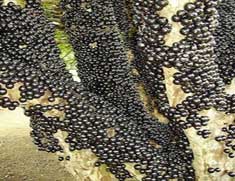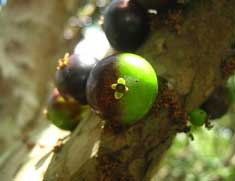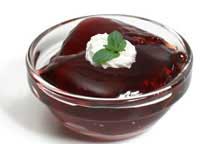 Full List of Fruits
Full List of Fruits  Jaboticaba Fruit
Jaboticaba Fruit
JABOTICABA FRUIT
Introduction to Jaboticaba Fruit
Jaboticaba Fruit-The Jaboticaba fruit is purple-black in color with plum-sized fruits cluster which is directly around the stem and main branches of the tree. These fruits are grape-like in appearance and also the flavor tastes as that of grapes, being sweet with an attractive sub acid tang. The fruits skin is tougher than grapes and this aids storage and handling.
Taste-The fruit Jaboticaba's appearance invited Trubus to taste those ripe fruits. Rosy Nur Apriyanti, Trubus reporter, picked up from the fruits. 'It tastes sweet,' as the grape like fruit flesh with soft texture was enjoyed by the tongue. "On the first day of the fruit picked, its flavour is like guava, and the second day it is like mangosteen, and the third day is lychee taste, the forth is passion fruit taste, the fifth is sweetsop fruit; the sixth up to the eighth is grape fruit nature of taste." The best flavor impression is on the ninth day when fruit becomes perfectly ripe and it tastes sweet and smells good.Scientific Name:Myrciaria cauliflora

Click on the below Jaboticaba you wish to find about
Jaboticaba Varieties
'Sabara', is a fruit variety of Jaboticaba a form of M. cauliflora and is the most prized and often planted variety in Brazil. The fruit is small, thin-skinned and sweet.
The tree is of medium size and produces fruits in abundance. Early in season bears four crops a year. At risk to corrosion on flowers and fruits.
'Paulista'-fruit is very large, with thick, leathery skin. It has a sweet taste in nature. The tree is a strong grower in the native place of this fruit and highly productive though it bears a single crop.
Later in season that it is 'Sabará' Fruits are opposed to rust. This fruit was introduced in 1994 in California.
'Rajada'-fruit is very large, skin like a green-bronze, it is thinner than that of 'Paulista' fruit. Flavor is sweet and very good to taste.
The tree is much like that of 'Paulista' fruit. The fruit of Rajada is grown in the Midseason.
'Branca'-fruit is large, not white, but bright-green and delicious. The tree produces small, pale whitish fruit, which becomes green when mature. The fruit has a different taste better than purple jaboticaba; it is flesh being soft, silky, sweet and very stimulating.
Fruits can also have a pale bronze shade.
'Ponhema'-fruit is medium in size,shaped with pointed apex in large, with rather leathery skin. Must be fully ripe for eating raw, it is most used for jelly and other conserve
Tree is very large and extremely productive. It looks greenish black in color and sweet to taste.
'Rujada'-fruit is striped white and purple in color. Its taste and size is like that of a grape fruit.
When ripe the Rujada fruit is hard to eat and jelly nature is less when compared to that of Ponhema variety.
Medicinal Uses: The treatment for hemoptysis, asthma, diarrhea and dysentery also as a gargle for chronic inflammation of the tonsils are by the caustic decoction of the sun-dry skins is agreed in Brazil. Such use of fruit also may lead to excessive consumption of tannin.
The fruit of Jaboticaba contain compounds similar to known to have positive biological effects in cranberries, grapes and other related species, including anti-ageing, anti-inflammatory and the antioxidant qualities.
| Nutritive value per 100 g of Jaboticaba | ||
| Principle | Nutritive value | |
| Fat | 0.00 g | |
| Protein | 1g | |
| Carbohydrates | 13g | |
| Calcium | 6mg | |
| Thiamin | 0.01 mg | |
| Phosphorus | 9mg | |
| Fiber | 0.6 g | |
| Vitamin C | 22mg | |
| Calories | 45 g | |
Grumichama Jelly - Jaboticaba Jelly
Method:
Wash the fruits, and then place into a large pan and just cover with water. Bring to the boil and boil for at least half an hour to an hour. Make sure the water does not want to evaporate. And add the mixture of Grumichamas/Jaboticabas into the boiled Jaboticaba and some less sugar to taste.
Cook for 5 mins and remove it from the stove once the process has been completed and add Jam setter and lime. Now the Jaboticaba jelly is ready to be served.
Jaboticaba Cheesecake
Ingredients:
- 1 kg of Jaboticaba fruit and enough water to cover the fruit
- 2 cups of sugar
- Juice of 1 lemon
- 2 cups wholemeal flour
- 4 oz butter
- 1 egg
- 1/2 cup sugar
- 2 packets of Philadelphia cream cheese
- 1 tin of condensed milk
- Juice of 1 lime
- 1 tbspn gelatine, dissolved in 2 tbspn boiling water
- 1 cup Jaboticaba jam
Directions:
Boil Jaboticaba fruit in water until the skin gets separated from the fruit, filter the remains and retain the juices. Re-boil the fruit again still it separated from the fruit. Add juice of lemon and gradually add sugar while stirring for taste. Simmer until thickened, and put into a jar while hot.
Melt butter and sugar together in microwave for 1 minute. Mix an egg and flour in a bowl with a fork, until smooth. Halve the mixture. Press into two flan tins. Bake in med-hot oven until brown.
Mix cream and cheese until smooth. Add strong milk and continue beating. Add lime juice and continue beating. Add Jaboticaba jam to continue beating. Add gelatine mixture and beat quickly until it thickens. Divide and pour into the two cooled pastry cases. Decorate with drizzled jam.























